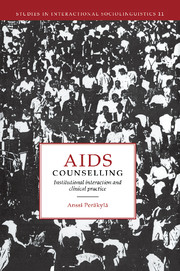Book contents
- Frontmatter
- Contents
- Preface
- Transcription conventions
- 1 Introduction
- 2 Quasi-conversational turn-taking
- 3 The client as owner of experience
- 4 The management of co-counsellors' questions
- 5 Some interactional uses of co-counsellors' questions
- 6 Addressing ‘dreaded issues’
- 7 The interactional power of hypothetical questions
- 8 Conclusion
- Appendix: the data base
- References
- Index
Appendix: the data base
Published online by Cambridge University Press: 02 December 2009
- Frontmatter
- Contents
- Preface
- Transcription conventions
- 1 Introduction
- 2 Quasi-conversational turn-taking
- 3 The client as owner of experience
- 4 The management of co-counsellors' questions
- 5 Some interactional uses of co-counsellors' questions
- 6 Addressing ‘dreaded issues’
- 7 The interactional power of hypothetical questions
- 8 Conclusion
- Appendix: the data base
- References
- Index
Summary
The data used in this study are video recordings from AIDS counselling sessions at two clinics in the Royal Free Hospital, London. The bulk of the data is from the Haemophilia Centre of that hospital, and some additional data has been collected from the HIV/AIDS clinic of the same hospital.
Due to my appointment as a Glaxo Research Fellow in the research project ‘Counselling with people who may be HIV positive’ (based at Goldsmiths' College and led by Professor David Silverman) I was granted access to the video archives of the Haemophilia Centre and the HIV/AIDS clinic of the Royal Free Hospital. The counselling sessions at the Haemophilia Centre are routinely video recorded for the purpose of using them for the preparation of subsequent sessions with the same patients, and for teaching and research. Recordings are made only if the patients give their consent. By the time of the beginning of the research project, the counsellors at the HIV/AIDS clinic had also begun to video record their sessions; but due to an increasing workload, they gave up this practice after about six months. The video archives of the two clinics currently consist of approximately 450 hours of counselling sessions.
Only a small fraction of the existing recordings could be used in this research. Some 40 sessions were initially examined. These were more or less randomly sampled, although interviews involving more than one client (a patient with his close associates) were preferred at some stages of the selection. Out of the sessions initially watched, 32 were used as data in the research.
Information
- Type
- Chapter
- Information
- AIDS CounsellingInstitutional Interaction and Clinical Practice, pp. 341 - 343Publisher: Cambridge University PressPrint publication year: 1995
